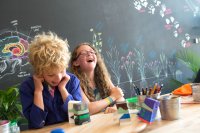Using Science to Bring Literature to Life
Combining science and literature can help students engage more deeply with both subjects.
Too often when we consider how to connect science and literacy, we think about using literature to support science. Maybe it’s reading a fictional book with a science theme, or exploring a biography of a famous scientist.
But we could instead turn that around and use science experiments as a way of bringing literature to life. Or we could use literature as a way to explore some of the questions about design and ethics that arise in the work of science.
As educators in Chicago, we saw that regardless of the setting, many students were not interested in science. They saw it as facts and rote memorization. In both our classwork and our outside workshops, we needed to create more meaningful connections to the sciences, and incorporating literature allowed students to engage in a different way.
The stories suddenly became something students could see, feel, and experience. They could see science as being creative. Showing students how scientific concepts connect to things that they’re passionate about allows them to gain confidence in science. It also challenges them to move beyond the traditional expectations of science classwork to become more open-minded and think creatively.
How We’ve Done It
Using science as a support to engage students with complicated texts: Beowulf is a classic story filled with monsters, a venomous fire-breathing dragon, undersea scrimmages, and battle descriptions including torn limbs and bloody, severed heads—like your basic video game.
Yet many of the high school students we’ve worked with were completely turned off because they found the language too difficult. Even when trying a variety of drawing and role-playing activities, it was still hard to get all of our students to completely engage.
So we created a series of science lessons to make the story more tangible. In one lesson, students are challenged to create their own 3D model of Grendel, Grendel’s mother, or the dragon. They must support their ideas by citing evidence from the text, and make and explain inferences where specific descriptions are not available. Students create paper robots, and learn the science behind circuitry by using LEDs to make their monsters light up. Battery-powered motors make the robots move.
Taking the lesson further, students can develop an arena where they set up their moving monsters to “fight” a Beowulf character. We discuss the probability of the outcomes, and discuss behavioral and physical characteristics of predators that occur in nature: What adaptations aid predators to overcome their prey? Which of these adaptations would need to occur in a monster in order for it to defeat Beowulf?
Students gain a deeper sense of the literature by thinking about alternate scenarios such as: What if Beowulf had lost to Grendel? What would it mean to our sense of the poem if Beowulf did not kill the dragon?
The lessons also incorporate chemistry, anatomy, and physiology to deepen inquiry and connections. We “myth-bust” to see if these events and monsters could really exist. What is a venomous dragon, and what toxins would the dragon secrete that would make it venomous? What would a fire-breathing dragon’s diet consist of to enable it to breathe fire? What would really happen if an arm was torn off in battle?
Using literature to help students understand the idea of responsibility in science: We hit upon the idea of using the story of Frankenstein to help make a potentially dry science unit on circuits more engaging. With students from the mid-elementary grades and up, we don’t read the novel but instead work with quotes from it to expand on what they know about the character, create deeper discussions, and incorporate reading comprehension skills.
We use Frankenstein’s monster to connect students to ideas of design and ethics in science. We role-play as our own Dr. Frankenstein, collecting a series of items to cobble together to build our own unique creatures. We learn about motors and circuitry to bring our mini-robots to life.
After going through the process as creators, students reflect on how much of their process was spent on bringing their creature to life vs. considering the design and function of their creature. This idea reconnects us to a deeper theme in the story—because the creature Dr. Frankenstein created is so ugly, people assume it’s evil. The creature looks at Frankenstein and says, “Accursed creator! Why did you form a monster so hideous that even you turned from me in disgust?”
Since people expect it to act like a monster, the creature eventually becomes one.
Students are then challenged to consider these questions:
- If Frankenstein created a beautiful creature, would people have responded to it differently?
- What was your process when you were deciding how your creature would look?
- What responsibility do scientists and inventors have to focus on the design as much as the purpose of their creation?
What We’ve Seen After These Lessons
These lessons draw in the students who don’t see themselves as scientists—they come to see that creativity can be a part of science. And they build confidence as they realize that science is broad—not just a singular subject. The lessons challenge the science-minded students to expand and think more creatively. And they’ve drawn many students toward independent reading and inquiry.
